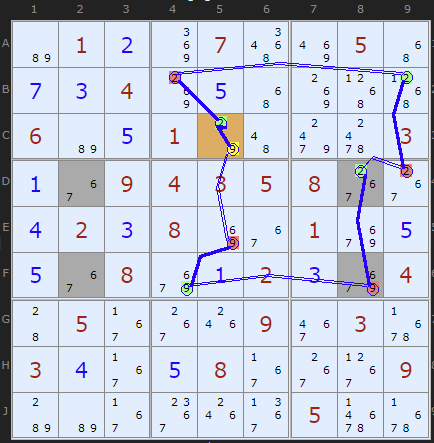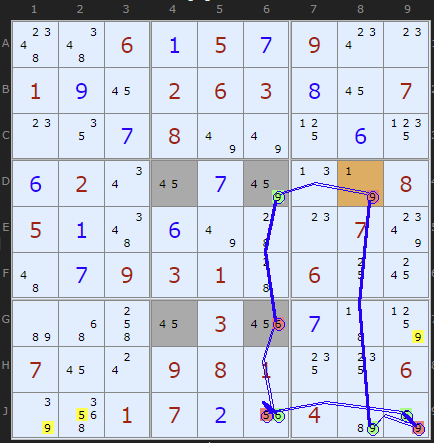| Main Page - Back |
|
From SudokuWiki.org, the puzzle solver's site |

Using Unique Rectangles as Links in Chains
We have already seen how chains can be built using Grouped Cells and Almost Locked Sets as more complex links, expanding the number of patterns available. In this article I detail how we can use the Unique Rectangle as another type of link. And it's relatively simple! At least for the basic Type 1 Unique Rectangle most often found.
This has been on my to-do list for a long time, but I have to credit David Hollenberg for giving me the inspiration and push to implement it in the solver, having given me some examples with Y-Wing chains.
Anywhere where chains can be used this type of link is valid.
In the first example we have a Discontinuous Alternating Nice Loop that starts and ends on C5. By tracing round it can be shown that if 2 on C5 is removed the chain reaction puts the 2 right back, implying it must be the solution. 9 Can be removed from that cell.
This has been on my to-do list for a long time, but I have to credit David Hollenberg for giving me the inspiration and push to implement it in the solver, having given me some examples with Y-Wing chains.
Anywhere where chains can be used this type of link is valid.
In the first example we have a Discontinuous Alternating Nice Loop that starts and ends on C5. By tracing round it can be shown that if 2 on C5 is removed the chain reaction puts the 2 right back, implying it must be the solution. 9 Can be removed from that cell.

But what is going on on F8 and D8? The chain jumps straight from -9 on F8 to +2 on D8. The reason is simple. The four shaded cells DF28 all contain 6/7 plus these other TWO candidates 2 and 9. We know from understanding unique rectangles (type 1) that we cannot allow all four of these cells to be reduced to 6 and 7 alone - that would give two solutions to the puzzles. So one of the extra candidates must exist (or maybe both!).
The chain coming into F8 takes off the 9 there. That forces D8 to be 2 (for the duration of the chain - we don't know yet). +2 on D8 allows us to continue the chain, in this case to D9.
AIC on 2 ((w.UR) Discontinuous Alternating Nice Loop, length 10):
-2[C5]+9[C5]-9[E5]+9[F4]-9(UR[DF28])+2[D8]-2[D9]+2[B9]-2[B4]+2[C5]
- Contradiction: When 2 is removed from C5 the chain implies it must be 2 - other candidates 9 can be removed

In this next example we have off-chain eliminations.
Removing the 6 from G6 endangers the solution by exposing the unique rectangle, so we can confidently turn ON the 9 in D6. That allows us to continue and close the loop.
(This is a much harder puzzle and might require some clicking to get to the interesting step)